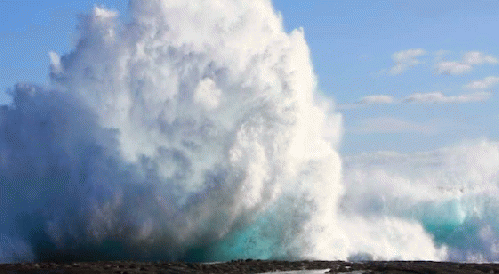
A methany hydrate deposit erupts in the sea just north of Norway
(Image by ThisCantBeHappening!) Details DMCA
Reports from the Arctic are getting pretty grim.
The latest, from a blog called Arctic News , warns that by 2026 -- that's just nine years from now -- warming above the Arctic Circle could be so extreme that a massively disrupted and weakened jet stream could lead to global temperature rises so severe that a massive extinction event, including humans, could result.
This latest blog post, written by Arctic News editor Sam Carana, draws on research by a number of scientists (linked in his article), who report on various feedback loops that will result from a dramatically warmer north polar region. But the critical concern, he says, is methane already starting to be released in huge quantities from the shallow sea floor of the continental shelves north of Siberia and North America. That methane, produced by bacteria acting on biological material that sinks to the sea floor, for the most part, is currently lying frozen in a form of ice that is naturally created over millions of years by a mixing of methane and water, called a methane hydrate. Methane hydrate is a type of molecular structure called a clathrate. Clathrates are a kind of cage, in this case made of water ice, which traps another chemical, in this case methane. At normal temperatures, above the freezing temperature of water, these clathrates can only form under high pressures, such as a 500 meters or more under the ocean, and indeed such clathrates can be found under the sea floor even in places like the bottom of the Gulf of Mexico, where the temperature is 8-10 degrees above freezing. But in colder waters, they can exist and remain stable at much shallower levels, such as a in a few hundred feet of water off the coast of Alaska or Siberia.
The concern is that if the Arctic Ocean waters, particularly nearer to shore, were to warm even slightly, as they will do as the ice cap vanishes in summer and becomes much thinner in winter, at some point the clathrates there will suddenly dissolve releasing tens of thousands of gigatons of methane in huge bursts. Already, scientists are reporting that portions of the ocean, as well as shallow lakes in the far north, look as though they are boiling, as released methane bubbles to the surface, sometimes in such concentrations that they can be lit on fire with a match as they surface.
As Carana writes:
"As the temperature of the Arctic Ocean keeps rising, it seems inevitable that more and more methane will rise from its seafloor and enter the atmosphere, at first strongly warming up the atmosphere over the Arctic Ocean itself - thus causing further methane eruptions - and eventually warming up the atmosphere across the globe."
That is scary enough, as a sufficient burst of methane, a global warming gas 86 times more powerful than CO2, could lead to a rapid rise in global temperatures by 3 degrees Celsius or more, enough to actually reverse the carbon cycle, so that plants would end up releasing more carbon into the atmosphere rather than absorbing it.
Is this scenario or a giant methane "burp" from the Arctic sea floor just a scare story?
Not according to many scientists who study the earth's long history of global warming periods and of evolution and periodic mass extinction events.
As Harold Wanless, a Professor of Geology and a specialist in sea level rise at the University of Miami explains, prior warming periods have often proceeded in dramatic pulses, not smoothly over drawn-out periods.
"We don't know how this period of warming is going to develop," he said. "That's the problem. The warming Arctic Ocean is just ice melting, but the melting permafrost in Siberia, and the methane hydrates under the shallow waters of the continental shelf can happen suddenly. Every model gets the trend, but they don't give you the rate that it happens or when something sudden happens."
(Note: You can view every article as one long page if you sign up as an Advocate Member, or higher).





